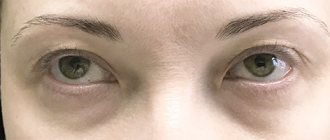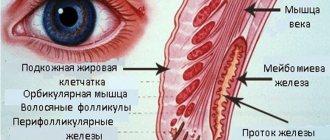Blepharoplasty "Cleopatra's Eye"
The image of Queen Cleopatra of Egypt is reflected not only in world fiction, but also in examples of ideals of beauty among different nations.
The almond-shaped eye shape given to Cleopatra by nature with amazing frequency is elevated by masters of art to the rank of “gold standard of beauty.” Aesthetic surgery, aimed at serving beauty, adopted the model of Cleopatra’s face and created a special method for correcting the shape of the eyes, called “Cleopatra’s Eye” and gaining increasing popularity in Russian cosmetology clinics. The Cleopatra Eye technique is a type of upper blepharoplasty. It is performed on the upper eyelid with raising the upper corner of the eye.
For the surgeon, two features of the “Cleopatra’s Eye” technique are significant, which serve as the basis for dividing the types of blepharoplasty into “classical” and “Cleopatra’s Eye”.
The first feature of the operation using the “Cleopatra's Eye” technique is a higher excision of the muscle and skin flap, which causes the lateral edge of the upper eyelid to be lifted upward and gives a small and characteristic bend in the middle of the projection of the eyeball onto the eyebrow.
The second feature is the surgeon’s work in the temporal region, during which he removes a wedge-shaped muscle flap, pulls the corner of the eye up and attaches it to the temporal fascia (canthopexy). It is canthopexy that allows you to strengthen the new shape of the eye and maintain the result for many years.
This technique allows you to create an anatomically intact almond-shaped eye without traces of a specially performed plastic surgery. Currently, surgery using the “Eye of Cleopatra” technique is one of the most popular in our clinics.
Indications for surgery using the “Eye of Cleopatra” technique:
- change in eye shape
- tired look
- ptosis (drooping) of the upper eyelid
- excess skin of the upper eyelids
- excess fatty tissue in the periorbital area
- drooping eyebrows and forehead skin
- laxity of the muscles of the periorbital zone
- wrinkles around the eyes
- exophthalmos – protrusion of the eyeball
- eye asymmetry
Contraindications to surgery using the “Eye of Cleopatra” technique:
- persistent arterial hypertension;
- systemic collagenoses;
- chronic infectious and viral diseases;
- acute inflammatory processes in the facial area;
- glaucoma;
- retinal detachment;
- diabetes;
- severe cardiovascular diseases;
- systemic connective tissue diseases (lupus erythematosus, scleroderma);
- disorders of the blood coagulation system;
- the presence of inflammatory elements on the skin of the eyelids.
Carrying out the operation:
The operation is carried out in four stages. The first stage is making a contour incision and removing skin from the outlined area of the surgical field. The next stage is the removal of excess orbicularis oculi muscle, which opens access to “fatty hernias”. When performing blepharoplasty using the “Cleopatra's Eye” technique, the excision is carried out with a vector to the middle of the eyebrow to achieve an anatomical almond-shaped shape. The incision should also include the temporal region, where canthopexy is performed after wedge excision. The third stage involves the isolation and removal of excess fatty tissue in the postorbital region. At the fourth and final stage, layer-by-layer stitching of the muscle and skin is carried out.
Anesthesia:
The operation is performed under local anesthesia; additional oral sedatives may be used. After the operation, an hour's observation of the patient's condition is sufficient; there is no need for the patient to stay in the hospital.
Rehabilitation requires compliance with the following rules:
- in the first days after surgery, avoid drinking large quantities of liquids, and also avoid drinking alcohol;
- take the antibiotic UNIDOX SOLUTAB for seven days - one tablet (at a dose of 100 mg) once a day, after meals;
- If there are noticeable bruises, use Traumeel S or Bruise OFF cream to speed up the resorption of hematomas. Apply the cream morning and evening to the hematoma area. It is strictly forbidden to apply cream to the seam area!
- sleep on your back for 4-5 days;
- avoid trauma to the operating area;
- refrain from visiting the bathhouse, sauna, solarium, swimming pool for 1 month;
- do not open wound coverings until the sutures are removed without the consent of the attending physician;
- Avoid intense physical activity for a month.
Postoperative rehabilitation takes from 5 to 10 days. The stitches are removed on days 6-9. If there are small traces of the suture after surgery, they are corrected by peeling or grinding methods in 1-3 sessions until the traces completely disappear.
Result:
The final result after the operation is observed after 3-4 months, when traces of the operation completely disappear, and lasts up to 20 years or more.
Cleopatra's look is every woman's dream
Every woman ages differently. One begins to quickly gain weight, the second dyes her hair to hide her gray hair, and the third has sagging breasts. But all these signs can be hidden with the help of properly selected clothes and high-quality hair dye. But what about the eyes and eyelids, which every day speak more vividly about the years we have lived?
Wrinkles in the eye area are mainly caused by a lack of collagen and excess fat. Hence the huge and heavy “bags”, which give their owner a sickly and exhausted look. And due to insufficient production of collagen fibers, folds and so-called “crow’s feet” appear. Is it possible to cope with this age-related defect? Undoubtedly. To do this, you need to get rid of the “bags” and stimulate collagen production.
It is worth noting that the appearance of problems in the eyelid area is not always associated with approaching old age. All people have different genetic predispositions, which can also cause the early appearance of wrinkles in the eye area. The patient's chronic illnesses are also important. For example, disease of the thyroid gland, cardiovascular system, kidneys, allergies and unhealthy lifestyle. If you dream of the look of Cleopatra, to return your eyelids to their former youth, you must first determine the reasons for their appearance and check your health.
Surgical methods for eyelid lift
To remove excess skin and fatty tissue, surgeons resort to classic anti-aging surgery - blepharoplasty. The doctor makes special incisions along the eyelash edge and in the folds of the eyelid, removes excess fatty tissue and then applies neat sutures. The entire procedure is performed under anesthesia.
If blepharoplasty is performed by a professional, you will look ten years younger and avoid possible complications.
In some cases, after blepharoplasty, bruising, swelling, tears and pain in the eyes may appear. These consequences of surgery disappear on their own within two weeks. Of course, such possible complications can stop you from taking a decisive step into the operating room. Many patients talk during consultations about their fears and are afraid to “risk their vision” for the sake of beauty: “After all, there are situations when the doctor tightens the skin a little and a feeling of discomfort arises?”
About twenty years ago, there were rumors among the population about our artists that they could not open their eyes normally. After all, they had plastic surgery, and now their eyelids are bothering them. However, if you get to a professional who did everything well, then you will not get any complications, and you will look ten years younger.
In transconjunctival blepharoplasty, which is a less invasive procedure, excess fat is removed from the lower eyelids using a small incision in the conjunctiva (lining). It is not possible to get rid of excess skin using this method, but this method provides short rehabilitation, the shape and shape of the eyes do not change at all, and facial expressions remain the same.
Non-surgical methods of skin rejuvenation in the eyelid area
There are other effective techniques for eyelid rejuvenation. With non-surgical blepharoplasty, the recovery period is shorter. The “magic” of eyelid lifting occurs without surgery, using modern hardware techniques - laser and radio wave lifting. It is impossible to radically remove drooping eyelids and “bags” under the eyes using this method, but with small or initial signs of age, you can still rejuvenate your look. Monopolar devices, which have high power, have a gentle effect on the skin tissue, so the result will be visible after the first procedure. For the best effect, one course of several sessions will be required.
Radio wave techniques include thermage and thermolifting. They use wave energy to penetrate the deep layers of the skin. Thus, under heating, old collagen cells are destroyed, and the production of new fibers is activated. Thermolifting is more suitable for rejuvenating the upper eyelids, but it will also be effective for the area around the eyes - the skin looks younger and becomes elastic. The results of the procedure last up to 5 years.
With fractional photothermolysis, the area near the eyes and forehead is corrected. The essence of the technique is that the laser precisely removes dead skin cells, thus making room for the formation of a renewed layer. Also, when heated, collagen is produced, which renews skin tissue. After several procedures with an interval of one and a half months, you can see obvious changes.
Plasmolifting is considered the most fashionable procedure today.
Maybe an injection
You can also rejuvenate the skin around the eyes with injections.
Carboxytherapy is the injection of carbon dioxide under the skin, which activates blood circulation. After the procedure, more oxygen enters the tissues and collagen production occurs. The consequence of this therapy is a decrease in the number of wrinkles, the disappearance of bruises and swelling. In addition, the recovery period after carboxytherapy, compared to other methods, is the shortest. There are also a minimum of contraindications.
Contour plastic surgery will be useful for those who have crow's feet and wrinkles on the lower eyelid. For this purpose, special fillers based on hyaluronic acid are used. The drugs are administered superficially, due to which the skin is leveled and filled with volume. In addition, fillers have a moisturizing effect. The effect lasts for six months. With regular use, you will not experience age-related changes.
Plasmolifting is considered the most fashionable and environmentally friendly procedure today. Plasma taken from the patient's own blood is injected under the skin. Since plasma is rich in platelets, the rejuvenation process activates the production of collagen and elastin. With plasma lifting there is no risk of allergies, because no foreign substances are introduced into the body. To achieve the expected result, a course consisting of four procedures will be required. The effect will last for about a year.











